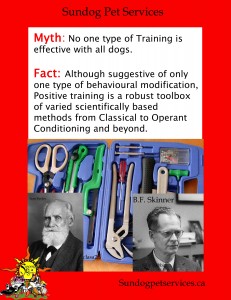Using Energy in Dog training? Numerous mystic words can be found when dog training is discussed; words like “Energy”, “Dominance”, or “Pack Leadership”. Talking of “Energy” is problematic. Like it or not, I use energy. Not “Energy” as others might use, but energy nonetheless.
(“Cellularrespiration“. Licensed under CC BY-SA 3.0 via Wikimedia Commons.)
Basics of Energy
Cellular Biology gives us the understanding of basic energy in animals (as well as plants, fungi and some bacteria). All of these use the Kreb’s Cycle to produce basic energy to power cellular processes. The net process of these reactions is ATP (Adenosine Tri-Phosphate). ATP is used by cells to power other processes. Extrapolating from that point backwards, where does the energy come from?
Sugars are converted to smaller compounds which form primary metabolic units needed in the Kreb’s Cycle. Proteins, Lipids (fats), and other carbohydrates are also mostly converted to sugars. Sugars, Lipids and Proteins come from food. To survive all animal cells need inputs of oxygen and food. Extrapolating forward, food provides energy which then flex muscles and fire neurons.
The Larger picture of Energy
Food powers cellular processes needed for cellular life and thus the whole organism. Other types of energy are either a subset of this energy, or mystical “Energy” that cannot be measured, is non-existent, or used to cover up the actual method of training.
Everything in a multi-cellular organism requires the basic processes powered by food to live. In order for an animal to move, think, digest, sleep, breath etc. they need food. Cellular energy is the basic unit of all other energies in an organism.
Neural impulses function off this energy. They fire muscular contractions, which also use cellular energy. So to get a dog to sit, the first need is food to power the impulse and then the contraction. Oxygen is delivered from the blood, which is created in the bone marrow (cellular division requires cellular energy) and the blood is pumped by the heart, a muscle that requires cellular energy to contract the muscle fibers. All in all, animals need food to function. Fear, pain, discomfort, enjoyment, fun and love (to name a few) require, at a basic level, cellular energy. Other types of “Energy” cannot provide an animal with the ability to move, think or even digest.
“Energy” usually means some mystical connection between trainer and dog. Is a possibility of ESP, Telepathy or other mystical force real? Science cannot and has not in 3000+ years measured or proven the existence of these mystical forces. Usually other means are being used being used involving food, discomfort or even pain. Using the term “Energy” does a disservice to pet parents attempting to determine the method best for their pet.
Training with Energy
So animals needs food to survive. Use of food seems to make the most sense in training. Not only is food something an animal needs, but most animals actually like food! (a built in evolutionary advantage-if you don’t like food, you don’t survive) Shunning food, for training shuns the very energy dogs need to survive. Denying food for training should lead to a question. What is being used to motivate the dog?
Motivation is important. Organisms seek to survive, procreate and thus pass on their genes. One key aspect to survival is getting food. Another key aspect of survival is avoiding danger. These are the main forms of motivation – getting good stuff and avoiding bad stuff. Most talk of “Energy” is a mask for the later, rather than the former. Motivating with bad stuff has bad potential side effects.
Covering up bad side effects with a term sounding comforting should be considered irresponsible at best, negligent at worst. Imagine a teacher saying that they use their “Energy” to train 5 year olds not be bullies; they then attach a noose around Johny’s neck and yank every time he kicks over someones sand castle. They claim they aren’t hurting the boy, because he’s respecting their “Energy”. They neglect to mention that the real (physical) energy they’re transferring could actually damage Johny’s neck, not to mention physiological trauma. Such a teacher would at the very least be fired. This is not uncommon in dog training however. Being aware of what is actually being used as a motivator is important. Using Energy in Dog Training? Use food.


